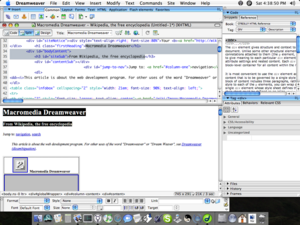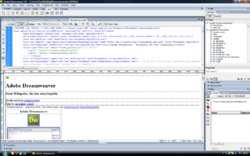Adobe Dreamweaver
Web Design & Development Guide
Adobe Dreamweaver
Home | Up
Adobe Dreamweaver, or simply Dreamweaver, is a
web development tool originally created by Macromedia (now Adobe Systems).
Initial versions of the application served as simple WYSIWYG HTML editors but
more recent versions have incorporated notable support for many other web
technologies such as CSS, JavaScript, and various server-side scripting
frameworks.
[1] The software is available for both the Mac and Windows platforms.
Dreamweaver is currently owned by Adobe Systems, which acquired Macromedia in 2005.
Features
As a WYSIWYG editor, Dreamweaver can hide the details of pages' HTML code
from the user, making it possible for non-coders to create web pages and sites.
A professional criticism of this approach is that it produces HTML pages whose
file size and amount of HTML code is much larger than they should be, which can
cause web browsers to perform poorly. This can be particularly true because the
application makes it very easy to create
table-based layouts. In addition, some web site developers have criticized
Dreamweaver in the past for producing code that often does not comply with W3C
standards though this has improved considerably in recent versions. Dreamweaver
8.0 (the version prior to the recently released 9.0 within CS3) performed poorly
on the Acid2 Test, developed by the Web Standards Project. However, Macromedia has increased the support for CSS
and other ways to lay out a page without tables in later versions of the
application, with the ability to convert tables to layers and vice versa.

Adobe Dreamweaver CS3
Dreamweaver allows users to preview websites in many browsers, provided that
they are installed on their computer. It also has some site management tools,
such as the ability to find and replace lines of text or code by whatever
parameters specified across the entire site, and a templatization feature for
creating multiple pages with similar structures. The behaviors panel also
enables use of basic JavaScript without any coding knowledge.
With the advent of version MX, Macromedia incorporated dynamic content
creation tools into Dreamweaver. In the spirit of HTML WYSIWYG tools, it allows
users to connect to databases (such as MySQL and Microsoft Access) to filter and
display content using scripting technologies such as Active Server Pages (ASP),
ASP.NET, ColdFusion, JavaServer Pages (JSP), PHP, and more without
any previous programming experience.
Dreamweaver 8.0 also included support for WYSIWYG XSLT editing, with CS3
extending on this functionality to introduce support for converting static HTML
to XSLT and performing fragmented XSL transformations on the server-side.
Dreamweaver can use "Extensions" - small programs, which any web developer
can write (usually in HTML and JavaScript). Extensions provide added functionality to the software for whoever wants to
download and install them. Dreamweaver is supported by a large community of
extension developers who make extensions available (both commercial and free)
for most web development tasks from simple rollover effects to full-featured
shopping carts.
Syntax highlighting

Dreamweaver MX 2004 running on Mac OS X v10.4 Tiger
As of version 8, Dreamweaver supports
syntax highlighting for the following languages out of the box:
-
ActionScript
- Active Server Pages (ASP)
ASP.NET
C#
-
Cascading Style Sheets (CSS)
- ColdFusion
EDML
Extensible HyperText Markup Language (XHTML)
Extensible Markup Language (XML)
Extensible Stylesheet Language Transformations (XSLT)
Java
JavaScript
JavaServer Pages (JSP)
PHP: Hypertext Preprocessor (PHP)
Visual Basic (VB)
Visual Basic Script Edition (VBScript)
Wireless Markup Language (WML)
It is also possible to add your own language syntax highlighting to its
repertoire.
Versions

Dreamweaver CS3 running on Microsoft Windows Vista
- Dreamweaver 1.0 (Released December
1997; Dreamweaver 1.2 followed in March 1998)
- Dreamweaver 2.0 (Released December
1998)
- Dreamweaver 3.0 (Released December
1999)
- Dreamweaver UltraDev 1.0 (Released June
2000)
- Dreamweaver 4.0 (Released December
2000)
- Dreamweaver UltraDev 4.0 (Released December
2000)
- Dreamweaver MX [Internal version number: 6.0] (Released May
2002)
- Dreamweaver MX 2004 (Released
September 10, 2003)
- Dreamweaver 8 (Released
September 13, 2005)
- Dreamweaver
CS3 (Released
April 16, 2007)
See also
External links
Home | Up | List of HTML editors | Adobe Dreamweaver | EditPlus | Microsoft FrontPage
Web Design & Development Guide, made by MultiMedia | Websites for sale
This guide is licensed under the GNU
Free Documentation License. It uses material from the Wikipedia.
|







